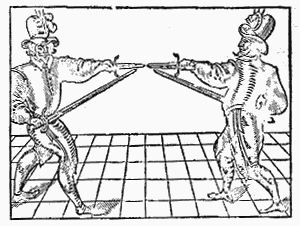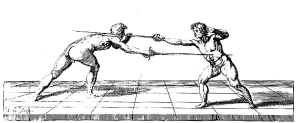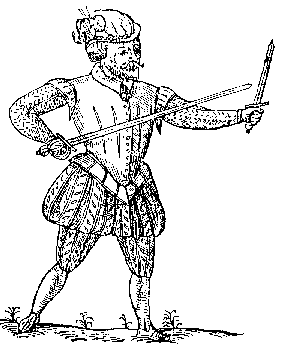
Journal of Western Martial Art
May 2000
Stephen Hand
Stephen Hand examines perhaps the most critical change in defensive technique in the entire history of western swordplay.
You face your opponent en guarde, waiting for his move. He lunges at the left side of your chest. Without thinking you parry the thrust across your body and then extend your sword in a counterthrust, aiming at the center of your opponent's chest. A perfect parry-riposte in quarte, simple, the first defensive maneuver we are taught in modern sport-fencing. Except that this riposte doesn't land. Your opponent has simply recovered from his lunge and your counterthrust has fallen short.
How can this be? Surely no one is quick enough to recover backwards before a riposte has time to land. If the weapons were foils or smallswords this statement would be true but our fictional fencers are not using these featherweight weapons. They are using rapiers, weighing a little over 1kg or approximately 2.5 lb. Against a competent opponent a parry-riposte does not work with a rapier.

Many people will find this statement surprising. They shouldn't. In order to be able to successfully perform a parry-riposte you must be able to perform two hand movements, accelerating your blade, stopping it and accelerating it in a different direction and you must be able to do all this faster than your opponent can recover from his lunge. Doing this with a foil or even with a smallsword is possible but doing it with a rapier isn't. A rapier is just too heavy. It has too much inertia and the movements are just too slow.
A quick glance at 16th and 17th century rapier fencing manuals shows not only that the parry-riposte was not used by the masters but that the technique had been considered and discarded (although the parry-riposte must have been used by some fencers, otherwise the masters would not have seen fit to argue against it). 'The question whether it was better to adopt the method of making two distinct motions in parrying and returning had been mooted and decided in the negative by nearly all the masters of the age. Fabris expresses himself even more decidedly in favour of the "stesso tempo", single time, against the "dui tempi", double time.' (Castle p.99)
Salvator Fabris' manual Fencing, On the Science of Arms(1606) is a model of clarity and is to be recommended to any student of the rapier. In his discussion of the concepts of time in defence he states 'In treating of the rule of the dui tempi, although it may succeed against some, it is not to be compared with the rule of parrying and hitting at the same time, because the true and safe method is to meet the body as it advances, before it has had time to withdraw and recover.' (Fabris p.10). Fabris states what is clear to modern students of the rapier, that while a parry with the blade might work, the subsequent riposte will only be successful if the attacking fencer has not chosen to recover from his lunge.
Capo Ferro (1610) while largely agreeing with Fabris, makes an important exception which serves merely to reinforce the truth of Fabris' comments. 'When the "dui tempi" are observed, as the parry is made, the left foot must first be brought up against the right, and then, as the attack is returned, the right foot must move forward.' (Castle p.112 translating and quoting Capo Ferro). So Capo Ferro is stating that in order for a parry-riposte to be successful the defender must step forward as he delivers the riposte. It is an admission that if this is not done the riposte, being too slow, will fall short.
In addition to the fact that a parry-riposte with a rapier is unlikely to be successful, it leaves you open to the same sort of techniques that are used today in modern fencing to deceive a parry. This passage is from Saviolo's "Practise" published in 1595. 'For if your enemie have skill in fence, and should not finde you to stand surely upon your gard in this assault, he might deliver a straight stoccata to your face, not purposing fully to hit him, which if you should breake with your Rapier, he might put his under yours, comming forward aside toward your right hande, and might give you a stoccata in the face.' (Saviolo p.20). For those who have difficulty with 16th century English the attacker feints a thrust at the face in the inside line and the defender attempts to parry in quarta. The attacker performs a cavatione or circular disengage under the defender's parry and continues on his thrust to strike the defender's face.

There are two important points here. Firstly Saviolo assumes that the only reason anyone might parry with the sword is if he is in a sloppy ward or perhaps nervous and incapable of reacting correctly. Secondly, note how the attacker is able to perform two hand motions more rapidly than the defender. The reasons for this are, one, the attacker moved first, a reason why this technique is still successful in foil fencing and two, because the required change in inertia between the attacker's two moves was significantly less than that between the defender's. The attacker's rapier continued to move forward at all times. Unlike the defender's first movement no muscular energy had to be expended to halt its motion. In practice a cavatione with a rapier is a far quicker move than a parry-riposte.
There were other ways in which rapier fencers could combat the parry-riposte, techniques with no modern equivalent. This one is again from Saviolo. 'Also if you should deliver a stoccata to your enemie, and that he should breake it with his Rapier, immediately you might remove with your left foot, your left hand, waiting on the weapon of your enemie, and give him an imbroccata or foine under or above his Rapier, and may be master of his weapon.' (Saviolo p.20). In this instance the attacker is feinting a thrust on the inside line. As the defender moves to parry, the attacker passes forward with the left leg, grabbing the hilt of the defender's rapier or simply moving the hand into a warding position to oppose a counterthrust. Simultaneously he avoids the parry with a cavatione, turning his hand into seconda (palm down) and thrusting with opposition to the defender's chest or face.
So, if our ancestors didn't use the double time defence, how did they defend themselves? The first line of defence was movement. There are a number of techniques where the defending fencer steps to the left or right, moving his body out of the line of attack. Here is an example from Saviolo, in fact the very first sequence he teaches.
'...then shall the maister begin to teach him, moving his right foot
somewhat on the right side in circle wise, putting the point of his Rapier
under his schollers Rapier, and so giving him a thrust in the belly.
L. And what then must the scholler doo?
V. At the selfesame time the scholler must remove with like measure
or counter-time with his right foote a little aside, and let the left foote
follow the right, turning a little his bodye on the right side, thrusting
with the point of his Rapier at the belly of his teacher' (Saviolo p.9).
The Maister moves to his right and thrusts, which the scholler counters by moving to his own right and counterthrusting. The counterthrust is simultaneous with the defensive traverse so that the entire defence is in single time.
The second line of defence was the left hand or what was held in it. Obviously a dagger or buckler can be held in the left hand and can be used to defend while simultaneously counterthrusting with the rapier. 'To avoid thrusts is always better - that is with the sword alone, for with the sword and the dagger you can parry with one weapon and hit at the same time with the other' (Fabris p.14).
The empty hand can be used in a similar fashion as Saviolo describes.
'L. But I praye you tell me, is it not better to breake with the Swoorde,
then with the hand? for (me thinketh) it should be dangerous for hurting
the hand.
V. I will tell you, this weapon must bee used with a glove, and if
a man should be without a glove, it were better to hazard a little hurt
of the hand, thereby to become maister of his enemies Swoorde, than to
breake with the swoord, and so give his enemy the advantage of him.' (Saviolo
p. 17).

The reason why the hand can be used in this way is, to quote George Silver (Paradoxes of Defence, 1599) 'the force of the thrust passeth straight, therefore any crosse being indirectly made, the force of a child may put it by' (p.21). Silver is arguing against the rapier masters' embrace of the thrust over the cut but his statement is valid, a rapier thrust may be batted aside with very little force.
Later masters, such as Fabris argued that the hand could be deceived in the same way as the rapier could 'To protect yourself with the hand is a miserable defence' (Fabris p. 15). On the following page Fabris goes on to say, 'As a general rule the hand should never be used except where you can reach the hilt and come to grips, a matter which does not concern us, who wish to treat only of the defence, the methods of making a hit and the advantage of arms, and not of scuffling.'
So if Fabris argued against both double time defence and the use of the left hand what method did he use to complement bodily avoidance? The techniques that he used would be described in modern sport fencing as time thrusts. Remember the first quote from Fabris, 'In treating of the rule of the dui tempi, although it may succeed against some, it is not to be compared with the rule of parrying and hitting at the same time, because the true and safe method is to meet the body as it advances, before it has had time to withdraw and recover.' (Fabris p.10). The time thrust is simply the process of parrying and hitting simultaneously by thrusting in a line which opposes the attack.
To parry and hit simultaneously the forte of the defender's rapier must oppose the foible or debile of the attacker's and the rapier point must be directed on target. In practice this requires superb timing. In order to achieve maximum point accuracy the point must strike the attacker at precisely the same moment his blade is parried. The defender must concentrate on point placement and the correct angulation of the blade. If he concentrates on making the parry his point accuracy will be adversely affected.
In short, time thrusts are hard. They are a lot harder than a parry-riposte. However, the benefits are twofold. Firstly, the counterattack is delivered while the attacker is necessarily within close distance. Secondly, as Fabris explains it provides a threat and makes it much harder for the attacker to deceive the parry and continue the attack. 'If you wish to parry knowing that you cannot hit, you must still carry your point as if you meant to hit, as this prevents the adversary from changing his line. Thus you free yourself from subjection and force your adversary to take the defensive since he is threatened with a time thrust, and his subjection gives an opportunity for a hit. Hence it is never necessary to parry without hitting, or making a feint of hitting in order to force your adversary to parry, so that you free yourself from danger and at the same time place him in danger.' (Fabris p. 14).
The move towards a more refined, less brutal form of swordplay finally severed the rapier from its martial origins and allowed the weapon to develop unhindered by the need to be practical against military weapons. The shortening and lightening of the rapier eventually had an effect on the nature of defence. 'The lightening of the sword forcibly brought the old question of "stesso tempo" or "dui tempi" to the front again. With the long rapier rapid action of the hand was obviously impossible, and offensive power had to be cultivated in the parries; in other words, the parry had to be formed in such a way as to act as a riposte. This resulted in a universal tendency to "time", and caused an amount of uncertainty in the parries which necessarily restricted the play, except when the dagger was adjoined to the sword. 'As the fashion in swords became lighter and shorter, the advantage of parrying first and riposting afterwards became more obvious'. (Castle p.138)
That advantage was primarily one of simplicity, the parry-riposte being
technically so much easier to execute than the time thrust. Once it was
no longer necessary to have a full military-size weapon it became possible
to conduct defence in double time. In terms of fencing the change from
defence in single time to defence in double time is perhaps the most significant
single change in the history of the art. It was not merely a change in
emphasis, it was a major paradigm change. The fact that this change took
place affects all our modern attempts to recreate rapier play. Most people
who develop an interest in historical fencing have a background in modern
sport fencing. It is therefore not surprising that we experience some difficulty
in accepting that most of the defensive techniques we have learnt in sport
fencing are inapplicable to the rapier and for the most part, to earlier
weapons. The majority of argument between practitioners about technique,
rules and choice of weapons revolve around this issue. That is why it is
so important to understand it.
Journal of Western Martial Art